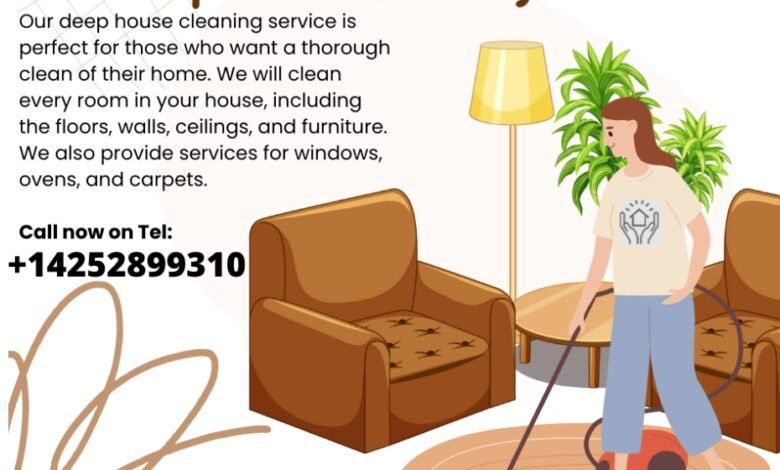Child-Friendly Cleaning: Keeping Your Home Safe for Kids

Cleaning your home is a routine task, but when you have children, it becomes imperative to ensure that your cleaning practices are practical and safe for their health and well-being. Child-friendly cleaning involves using products and methods that minimize the risk of exposure to harmful chemicals and allergens while effectively removing dirt and germs. According to the American Academy of Pediatrics, exposure to household chemicals can have serious health consequences for children, including respiratory issues, skin irritation, and even neurodevelopmental disorders. This highlights the importance of adopting child-friendly cleaning practices to protect the health of your little ones. If you’re in Seattle and need assistance, consider hiring professional home cleaning services Seattle to ensure your cleaning practices align with the safety standards required for a child-friendly environment.
Pro tip: Always opt for cleaning products labeled as “non-toxic” or “child-safe” to minimize exposure to harmful chemicals. Additionally, consider using natural alternatives like vinegar, baking soda, and lemon juice for a safer cleaning experience.
Understanding Common Household Chemicals
Many conventional cleaning products contain harsh chemicals such as bleach, ammonia, and phthalates, which can pose serious health risks, especially to children. Bleach, for example, emits fumes that can irritate the respiratory system and skin upon contact. Ammonia, another common ingredient in cleaning products, can cause respiratory issues and skin irritation, particularly in children with asthma or sensitive skin. Phthalates, found in many fragranced cleaning products, have been linked to hormonal disruptions and developmental issues in children. To mitigate these risks and ensure a safer environment for your family, consider hiring a professional Seattle home cleaner specializing in non-toxic and child-safe cleaning products.
Pro tip: When selecting cleaning products, carefully read the labels and avoid products containing harsh chemicals like bleach, ammonia, and phthalates. Instead, opt for safer alternatives labeled as “green” or “eco-friendly,” free from these harmful ingredients and pose less risk to your family’s health.
The Impact of Chemical Exposure on Children’s Health
Exposure to household chemicals can harm children’s health, ranging from respiratory problems to neurodevelopmental disorders. Studies have shown that children are more vulnerable to the adverse effects of chemical exposure due to their smaller size, developing organs, and higher metabolic rates. For instance, repeated exposure to cleaning products containing volatile organic compounds (VOCs) has been associated with an increased risk of asthma and other respiratory conditions in children.
Pro tip: To minimize the risk of chemical exposure, ventilate your home while cleaning by opening windows and using exhaust fans. Additionally, store cleaning products should be securely out of reach of children, and safety guidelines should be followed on product labels to reduce the risk of accidental ingestion or contact.
Safe Cleaning Practices for Child-Friendly Homes
Implementing safe cleaning practices is essential for maintaining a healthy environment for children. This includes using cleaning products specifically formulated to be safe for children and pets and following proper storage and usage guidelines. Additionally, it’s important to keep cleaning supplies out of reach of children and to educate them about the potential dangers associated with household chemicals.
Pro tip: Involve children in cleaning tasks using child-safe products to teach them responsible habits from a young age. This helps them develop essential life skills and instills a sense of ownership and pride in maintaining a clean and healthy home environment.
DIY Cleaning Solutions for a Safer Home Environment
Creating homemade cleaning solutions using natural ingredients is cost-effective and safer for children and the environment. Ingredients like vinegar, baking soda, and lemon juice have natural cleaning properties and can effectively remove dirt, stains, and odors without harsh chemicals. DIY cleaning solutions are also customizable, allowing you to tailor them to your specific cleaning needs.
Pro tip: Stock your pantry with basic ingredients like vinegar, baking soda, and essential oils to whip up homemade cleaning solutions whenever needed. These ingredients are safer and more eco-friendly than commercial cleaning products, but they’re also budget-friendly and readily available.
Managing Allergens and Asthma Triggers in the Home
Children are particularly susceptible to allergens and asthma triggers in the home environment. Dust mites, pet dander, mold, and pollen are common culprits that can exacerbate allergies and asthma symptoms. To mitigate these risks, it’s essential to maintain a clean and allergen-free home by regularly vacuuming, dusting, and addressing moisture issues.
Pro tip: Invest in a high-quality HEPA-filtered vacuum cleaner to effectively capture allergens and pollutants from carpets, rugs, and upholstery. Additionally, regularly wash bedding, curtains, and stuffed toys in hot water to eliminate dust mites and other allergens.
Importance of Proper Storage and Disposal of Cleaning Products
Proper storage and disposal of cleaning products are critical to prevent accidental ingestion or exposure, especially for young children. Keep cleaning products securely locked away in cabinets or storage containers out of reach of children and pets. Additionally, be mindful of expiration dates and safely dispose of expired or unused cleaning products according to local regulations.
Pro tip: Consider installing child-resistant locks on cabinets or drawers where cleaning products are stored to prevent curious children from accessing potentially harmful chemicals. Be sure to keep the Poison Control hotline number readily available in case of accidental ingestion or exposure to cleaning products.
Creating Child-Friendly Cleaning Routines
Incorporating cleaning into your family’s routine can instill a sense of responsibility and ownership in children while maintaining a clean and organized home. Assign age-appropriate cleaning tasks to children and establish a regular cleaning schedule that fits your family’s lifestyle. Make cleaning fun by turning it into a game or offering rewards for completing tasks.
Pro tip: Break down cleaning tasks into smaller, manageable steps and involve children in decision-making, such as choosing cleaning supplies or organizing their belongings. Making cleaning a collaborative and enjoyable activity makes children more likely to participate willingly and take pride in their contributions.
Educating Children About Safe Cleaning Practices
Teaching children about safe cleaning practices is essential for their safety and well-being. Start by explaining the potential dangers of household chemicals and demonstrating proper usage and handling techniques. Use age-appropriate language and visuals to convey important safety information and encourage children to ask questions.
Pro tip: Incorporate hands-on demonstrations and role-playing activities to reinforce safe cleaning practices and empower children to maintain a clean and healthy home environment actively. By involving children in the learning process, they better understand the importance of safety and responsibility.
Green Cleaning Products: What to Look For
With the increasing demand for environmentally friendly cleaning products, a wide array of options are available on the market. When choosing green cleaning products, look for certifications and labels that indicate they meet strict environmental and safety standards. For example, products labeled with the EPA Safer Choice logo have undergone rigorous testing to ensure they are safe for both people and the planet.
Pro tip: Read product labels carefully to understand the ingredients used in green cleaning products and their potential impact on health and the environment. Look for plant-based ingredients, biodegradable formulations, and minimal packaging to minimize your carbon footprint.
The Environmental Impact of Conventional Cleaning Products
The production and use of conventional cleaning products can have significant environmental consequences, contributing to pollution, water contamination, and greenhouse gas emissions. Ingredients such as phosphates, chlorine, and synthetic fragrances are often derived from non-renewable resources and can have long-lasting effects on ecosystems and wildlife.
Pro tip: Opting for eco-friendly cleaning products reduces your household’s environmental footprint and supports companies that prioritize sustainability and ethical sourcing. By making informed choices about your products, you can help protect the planet for future generations.
Importance of Regular Cleaning and Maintenance
Maintaining a clean and organized home is essential for promoting a healthy indoor environment and preventing the spread of germs and allergens. Regular cleaning tasks such as vacuuming, dusting, and disinfecting high-touch surfaces help reduce the buildup of dirt, dust, and bacteria, improving indoor air quality and reducing the risk of illness.
Pro tip: Create a cleaning schedule that includes daily, weekly, and monthly tasks to ensure all areas of your home are regularly maintained. Focus on high-traffic areas such as kitchens, bathrooms, and living rooms, where germs and bacteria are most likely to accumulate.
Childproofing Your Cleaning Supplies
Childproofing your cleaning supplies is essential for preventing accidental poisoning or exposure to harmful chemicals—store cleaning products securely in locked cabinets or storage containers out of reach of children and pets. Keep products in original containers with intact labels to prevent confusion or accidental ingestion.
Pro tip: Consider investing in child-resistant safety locks for cabinets or drawers where cleaning products are stored, especially if you have young children or curious pets. Keep all cleaning supplies organized and easily accessible for adults while remaining inaccessible to children.
Addressing Indoor Air Quality Concerns
Indoor air quality can significantly impact children’s health and well-being, particularly those with asthma or allergies. Poor indoor air quality can exacerbate respiratory symptoms and contribute to long-term health issues. To improve indoor air quality, focus on proper ventilation, air filtration, and minimizing sources of indoor pollution.
Pro tip: Open windows and doors regularly to allow fresh air to circulate throughout your home and reduce indoor air pollutants. Consider using air purifiers with HEPA filters to remove airborne allergens and pollutants, especially in areas prone to mold or dust buildup. Additionally, avoid smoking indoors and minimize using candles, air fresheners, and other sources of indoor pollution.
Teaching Children Responsibility Through Cleaning
Involving children in household chores helps lighten the load for parents, teaches valuable life skills, and instills a sense of responsibility in children from a young age. Assigning age-appropriate cleaning tasks allows children to contribute to the household while learning important lessons about teamwork, accountability, and self-reliance. Additionally, completing chores can boost children’s self-esteem and confidence as they see the tangible results of their efforts.
Pro tip: Start by assigning tasks matching your child’s age and abilities, such as putting away toys, folding laundry, or wiping down surfaces. As children grow older, gradually increase the complexity of their chores and involve them in decision-making processes, such as creating a cleaning schedule or organizing household supplies. Be sure to praise and encourage children for their efforts, focusing on their progress rather than perfection.
Encouraging a Minimalist Approach to Cleaning
Embracing a minimalist approach to cleaning can simplify your life and create a more serene and organized living space for your family. Minimalism is about intentionally choosing to live with less and focusing on what brings joy and value to your life. By decluttering your home and minimizing possessions, you can reduce the time and energy spent on cleaning and maintenance while creating a more visually appealing and stress-free environment.
Pro tip:
- Start by decluttering one area of your home at a time, focusing on items that no longer serve a purpose or bring you joy.
- Donate or sell items in good condition but no longer needed, and dispose of broken or unused items responsibly.
- Embrace a mindset of gratitude and mindfulness as you simplify your surroundings and prioritize experiences and relationships over material possessions.
Incorporating Green Practices into Your Cleaning Routine
Transitioning to eco-friendly cleaning practices benefits the environment and promotes a healthier home for your family. Using natural, non-toxic cleaning ingredients and reducing waste can minimize your carbon footprint and create a more sustainable lifestyle. Green cleaning practices focus on using renewable resources, reducing energy consumption, and minimizing the use of harmful chemicals that can harm both human health and the environment.
Pro tip: Replace disposable cleaning products such as paper towels and wipes with reusable alternatives such as microfiber cloths and washable mop pads. Use eco-friendly cleaning tools such as bamboo scrub brushes and natural bristle brooms made from renewable materials and biodegradable at the end of their lifespan. Additionally, consider making your cleaning products using simple ingredients like vinegar, baking soda, and essential oils for a safer, more sustainable approach to cleaning.
Investing in High-Quality Cleaning Equipment and Tools
Investing in high-quality cleaning equipment and tools can make your cleaning tasks more efficient and effective while reducing the need for harsh chemicals and excessive scrubbing. Look for durable, ergonomic cleaning tools to tackle tough messes and withstand regular use. High-quality cleaning equipment can save you time and effort in the long run, allowing you to achieve professional-quality results with minimal hassle.
Pro tip: Choose cleaning equipment and tools for specific tasks and surfaces, such as microfiber cloths for dusting and polishing and scrub brushes with stiff bristles for tackling grime and stains. Consider investing in a HEPA-filtered vacuum cleaner for removing allergens and pollutants from carpets and upholstery and a steam cleaner for deep cleaning and sanitizing hard surfaces without harsh chemicals. Investing in high-quality cleaning equipment and tools allows you to achieve superior cleaning results while minimizing your environmental impact.
Seeking Professional Help When Needed
While regular cleaning and maintenance are essential for keeping your home clean and healthy, there may be times when professional help is needed for deep cleaning or specialized tasks. Professional cleaning services can provide expertise, experience, and specialized equipment to tackle tough messes and ensure your home is thoroughly cleaned and sanitized.
Pro tip: Research cleaning companies thoroughly and read reviews from past customers to ensure they meet your standards for quality and reliability. Ask for recommendations from friends, family members, or neighbors who have used cleaning services in the past, and request references from prospective cleaning companies before making a decision. By seeking professional help, you can save time and effort while ensuring your home remains clean, safe, and healthy for your family.
Conclusion: Creating a Safe and Healthy Home Environment for Children
In conclusion, prioritizing child-friendly cleaning practices is essential for creating a safe and healthy home environment for your family. By using non-toxic cleaning products, implementing safe cleaning practices, and involving children in household chores, you can promote a clean and organized living space while minimizing the risk of exposure to harmful chemicals and allergens. Additionally, embracing green cleaning practices, minimalism, and investing in high-quality cleaning equipment can further enhance the cleanliness and sustainability of your home. By creating a clean and healthy home environment, you can provide a nurturing and supportive space for your children to thrive and grow.



